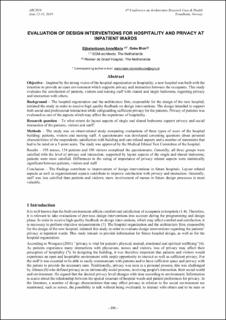| dc.description.abstract | Objective – Inspired by the strong vision of the hospital organization on hospitality, a new hospital was built with the intention to provide an open environment which supports privacy and interaction between the occupants. This study evaluates the satisfaction of patients, visitors and nursing staff with shared and single bedrooms, regarding privacy and interaction with others.
Background – The hospital organization and the architecture firm, responsible for the design of the new hospital, initiated the study in order to receive high quality feedback on design interventions. The design intended to support both social and professional interaction while safeguarding sufficient privacy for the patients. Privacy of patients was evaluated as one of the aspects which may affect the experience of hospitality.
Research question – To what extent do layout aspects of single and shared bedrooms support privacy and social interaction of the patients, visitors and staff?
Methods – The study was an observational study comparing evaluations of three types of users of the hospital building: patients, visitors and nursing staff. A questionnaire was developed consisting questions about personal characteristics of the respondents, satisfaction with building and care related aspects and a number of statements that had to be rated on a 5-point scale. The study was approved by the Medical Ethical Test Committee of the hospital.
Results – 195 nurses, 154 patients and 150 visitors completed the questionnaire. Generally, all three groups were satisfied with the level of privacy and interaction, supported by layout aspects of the single and shared bedrooms; patients were most satisfied. Differences in the rating of importance of privacy related aspects were statistically significant between patients, visitors and staff.
Conclusion – The findings contribute to improvement of design interventions in future hospitals. Layout related aspects as well as organizational aspects contribute to improve satisfaction with privacy and interaction. Generally, staff was less satisfied than patients and visitors; more involvement of nurses in future design processes is most valuable. | |

